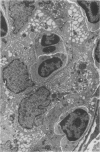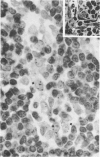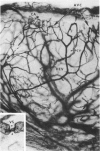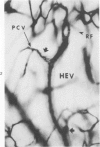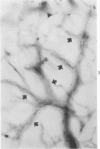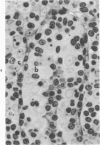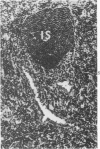Abstract
Histological, histochemical, ultrastructural, and radiolabeling characteristics of the microvasculature in regional nodes draining skin allograft sites are described. From 12 to 48 hours after grafting, these nodes show increased vascular permeability and altered lymphocyte traffic pattern. The rapid rise in lymphocyte migration indices and the apparent plugging of intermediate sinuses by lymphocytes suggest that both increased entry and decreased egress of recirculating cells contribute in "lymphocyte trapping." This is followed by redistribution of cortical capillary arcades as existing germinal centers dissolve and proliferating lymphocytes infiltrate the cortex. Normal microvascular patterns reappeared at 7 to 14 days as primary and secondary nodules form in the enlarged nodes. Increased length and arborization of high endothelial venules resulted from focal proliferation of endothelial cells in transition zones from high to low endothelium. In stimulated nodes, high endothelial cells exhibit increased cytoplasmic basophilia and acid hydrolase activities which correlate with the appearance of numerous polyribosomes, RER cisternae, and lysosomes in their cytoplasm. These "activated" endothelial cells phagocytose microthrombi within venular lumens.
Full text
PDF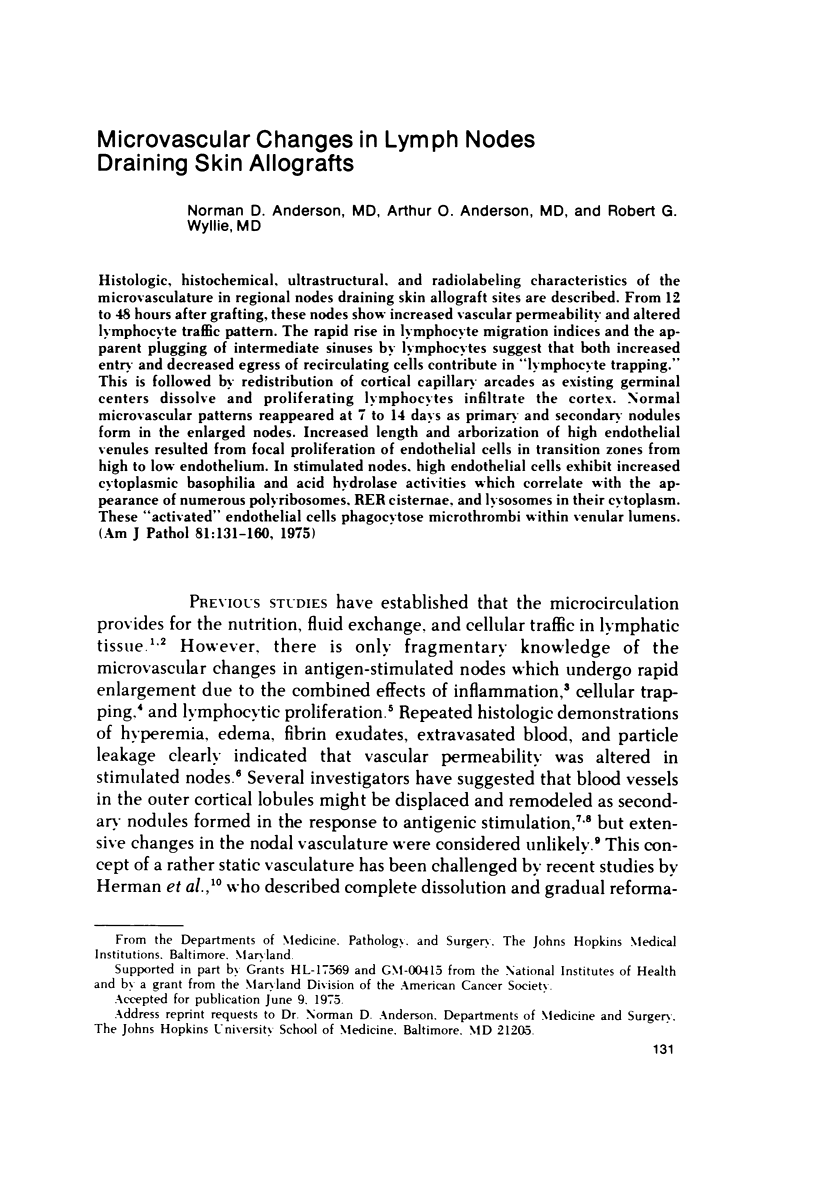
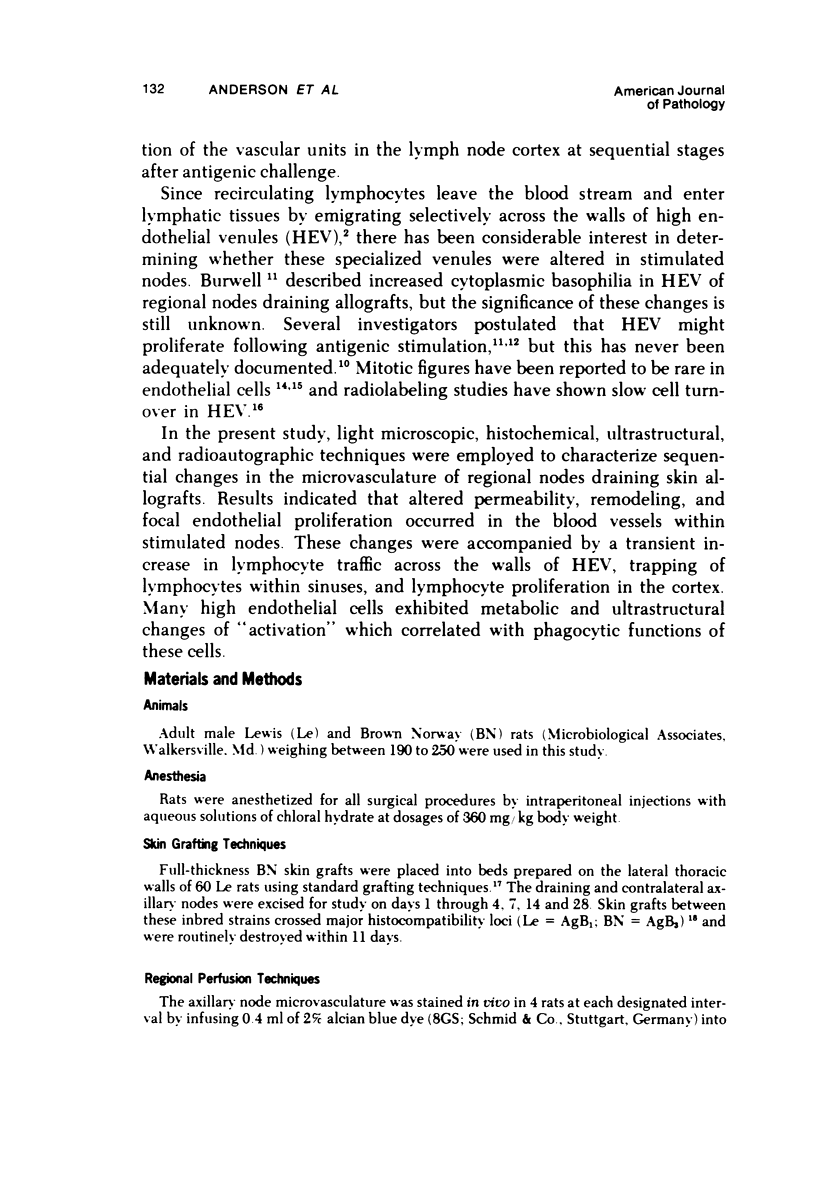
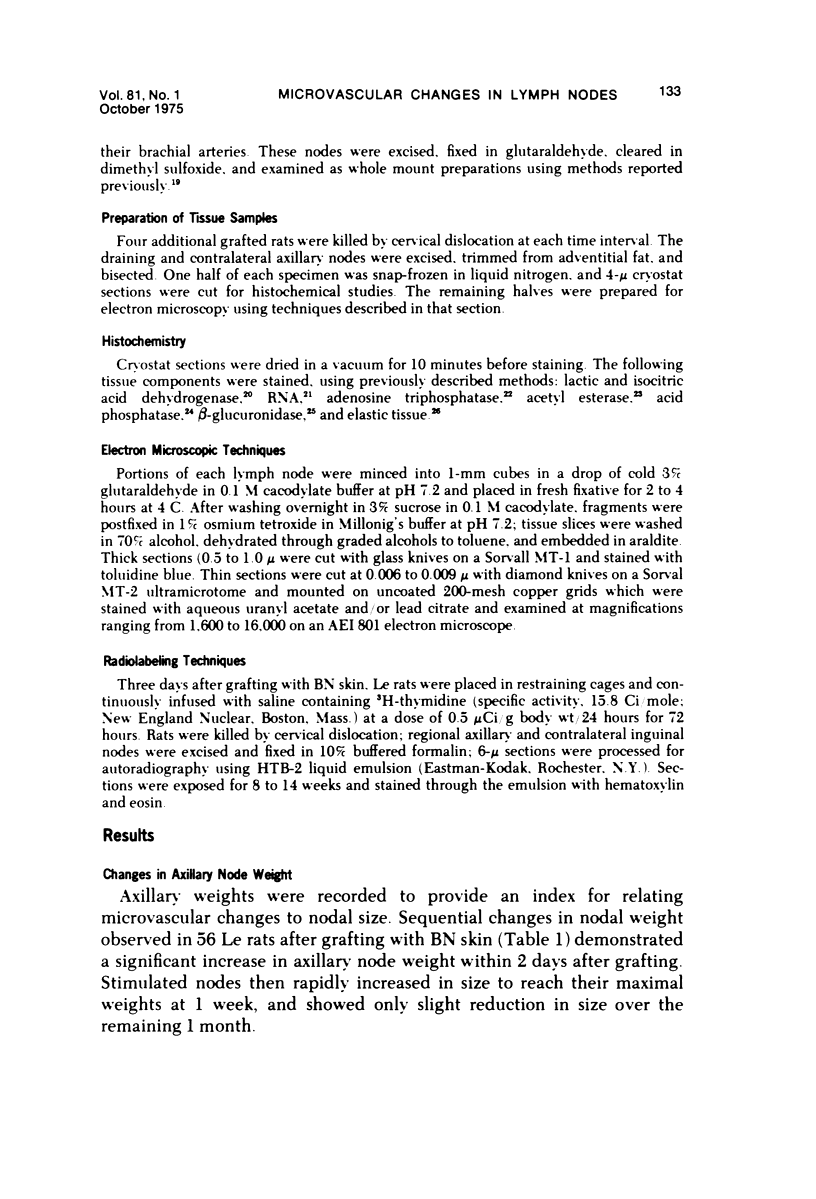
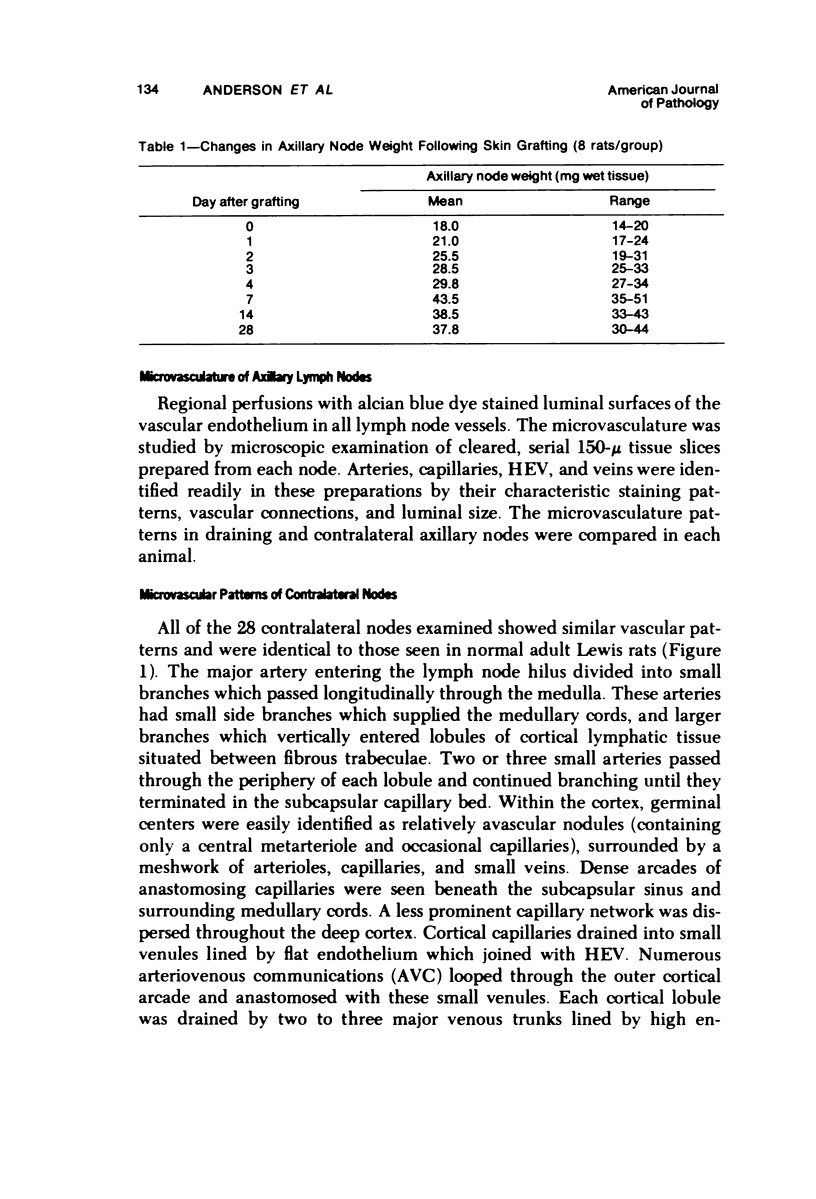
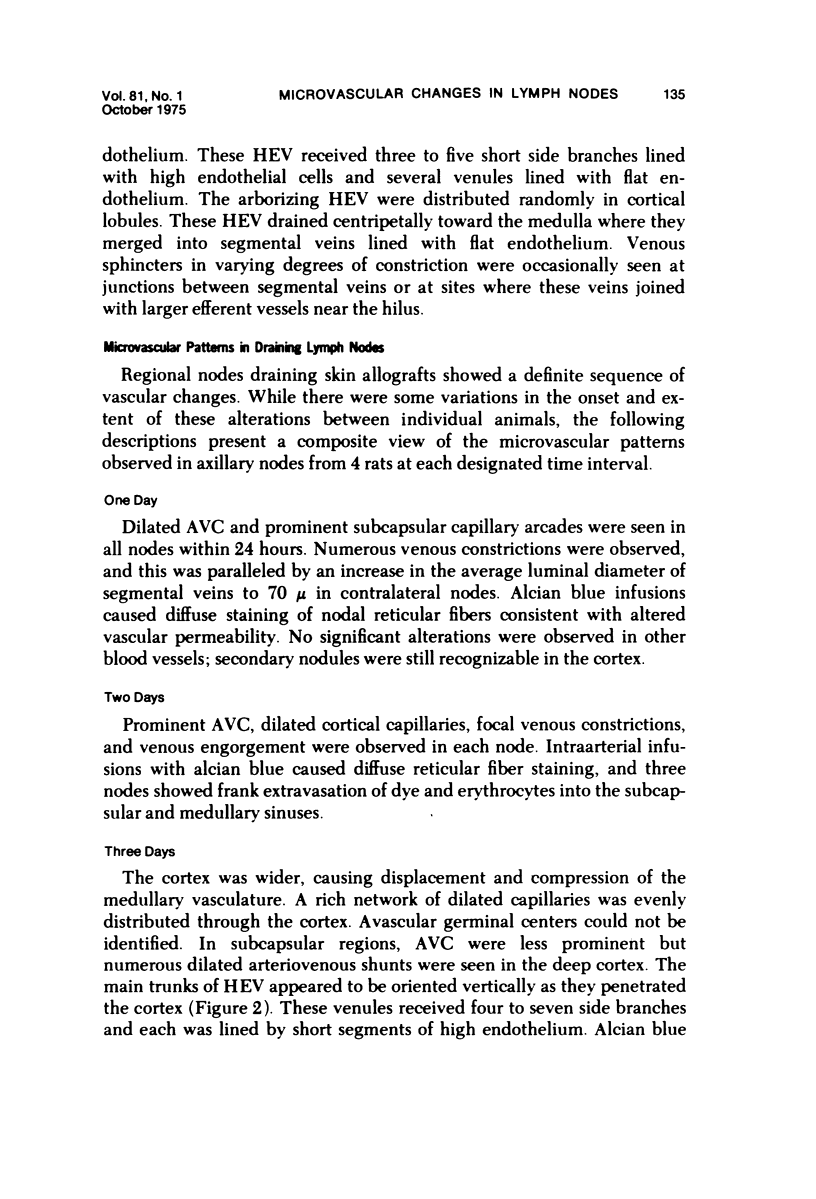
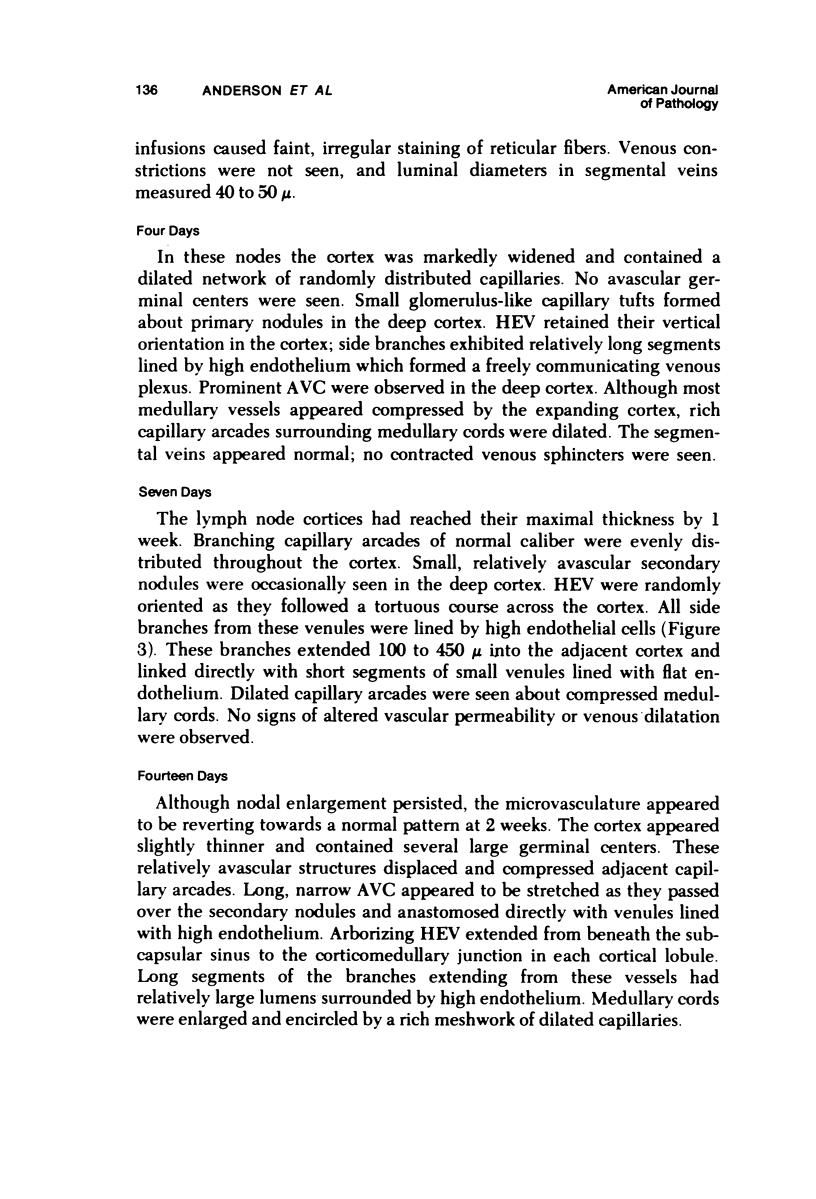
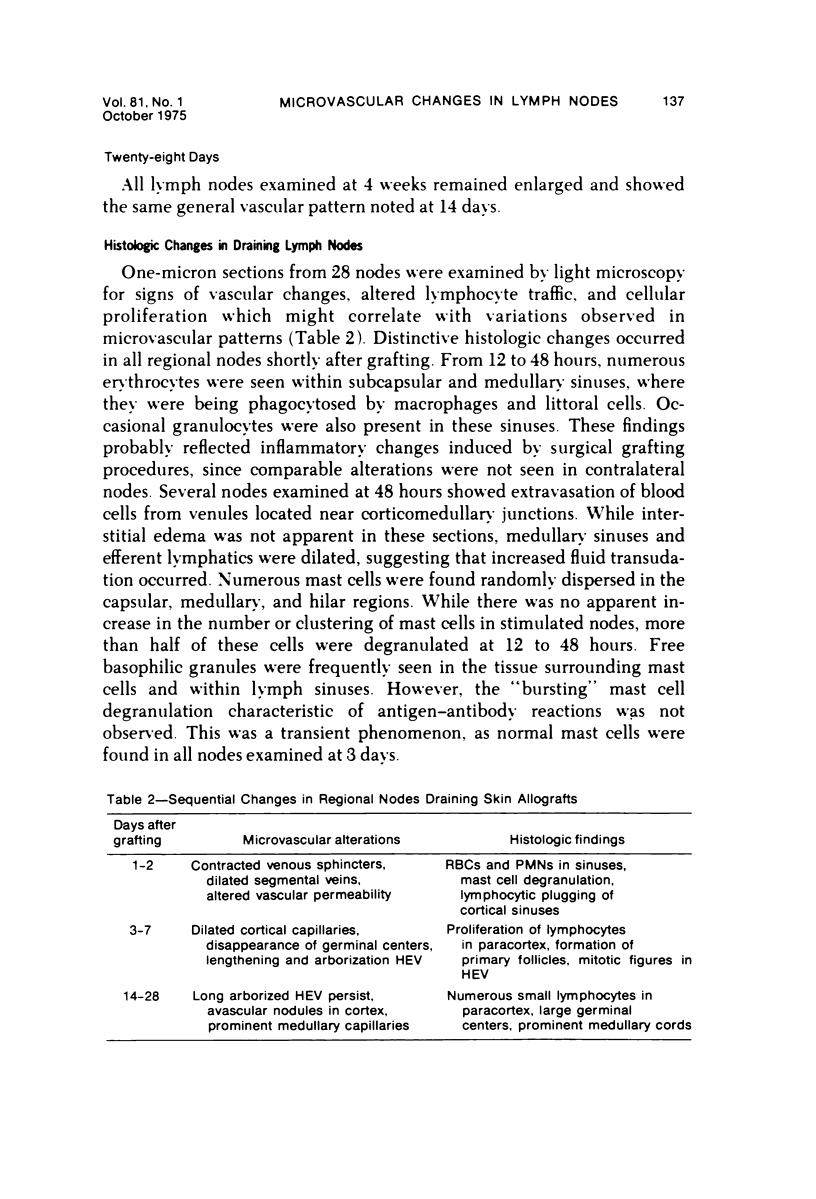
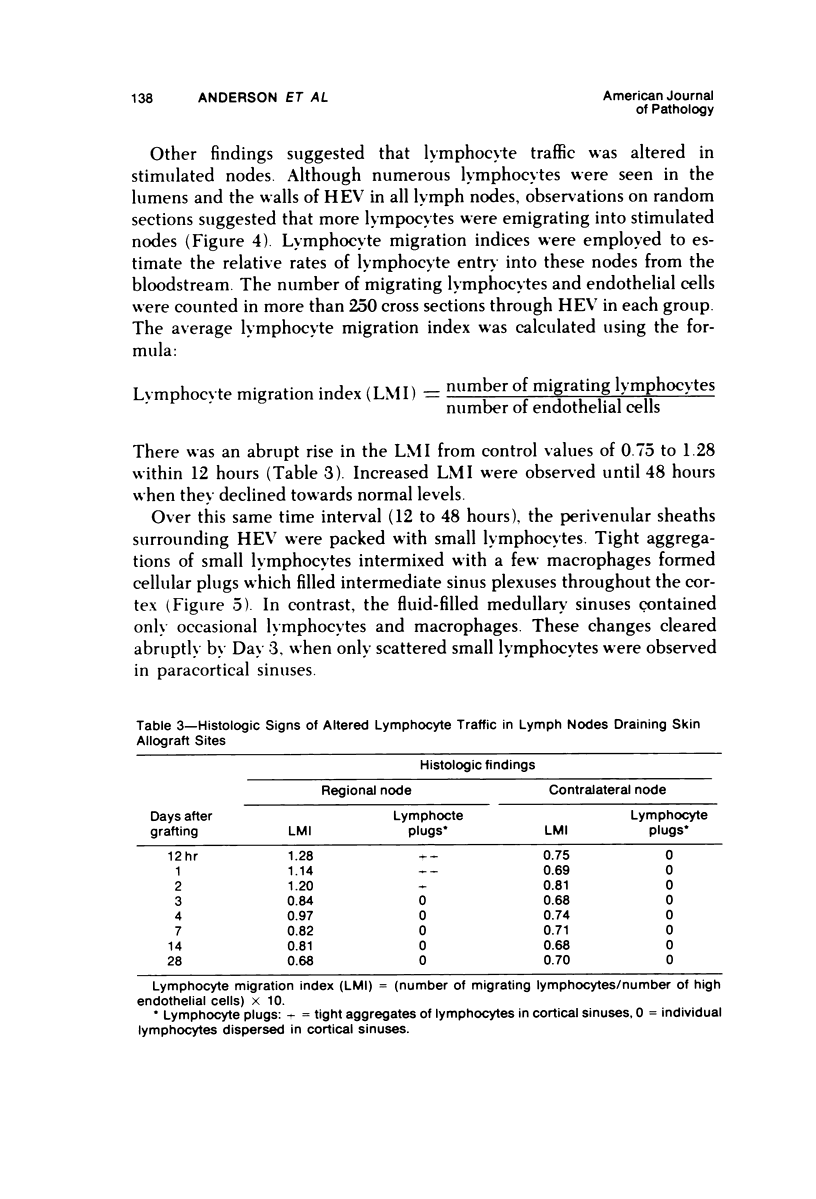
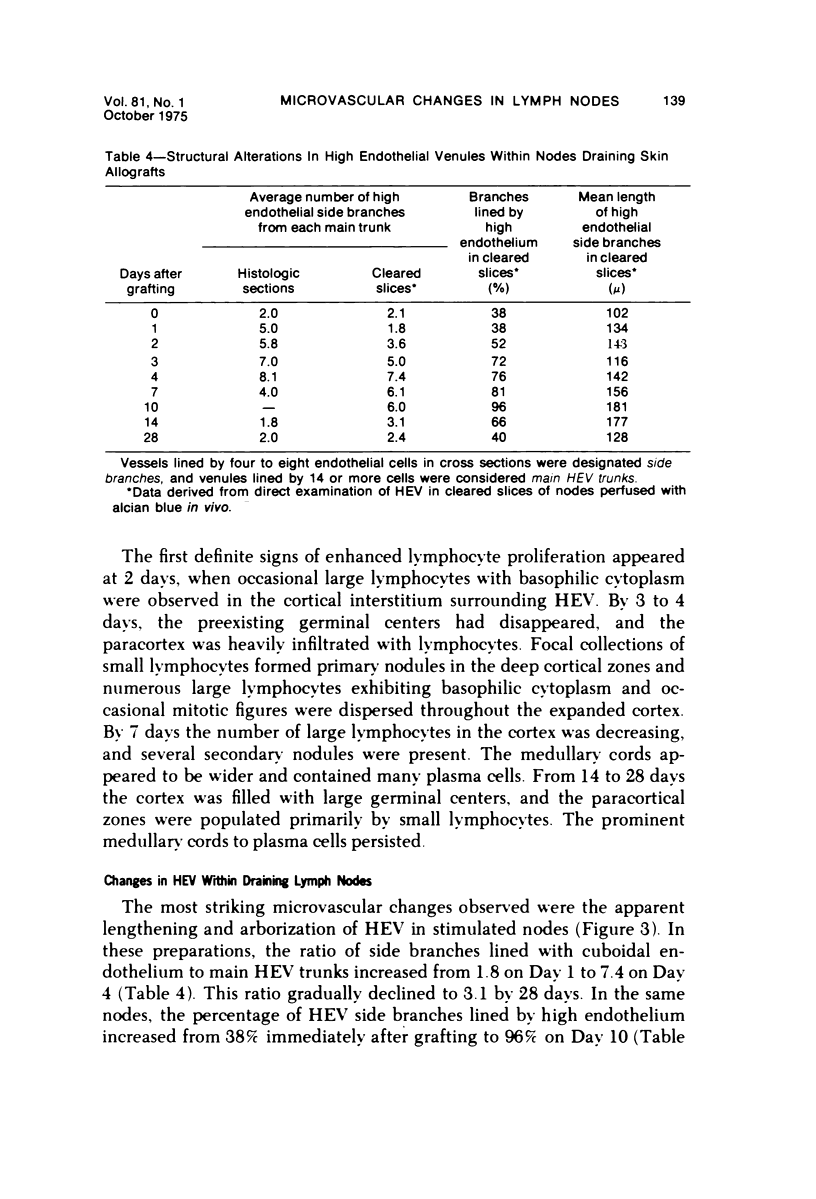
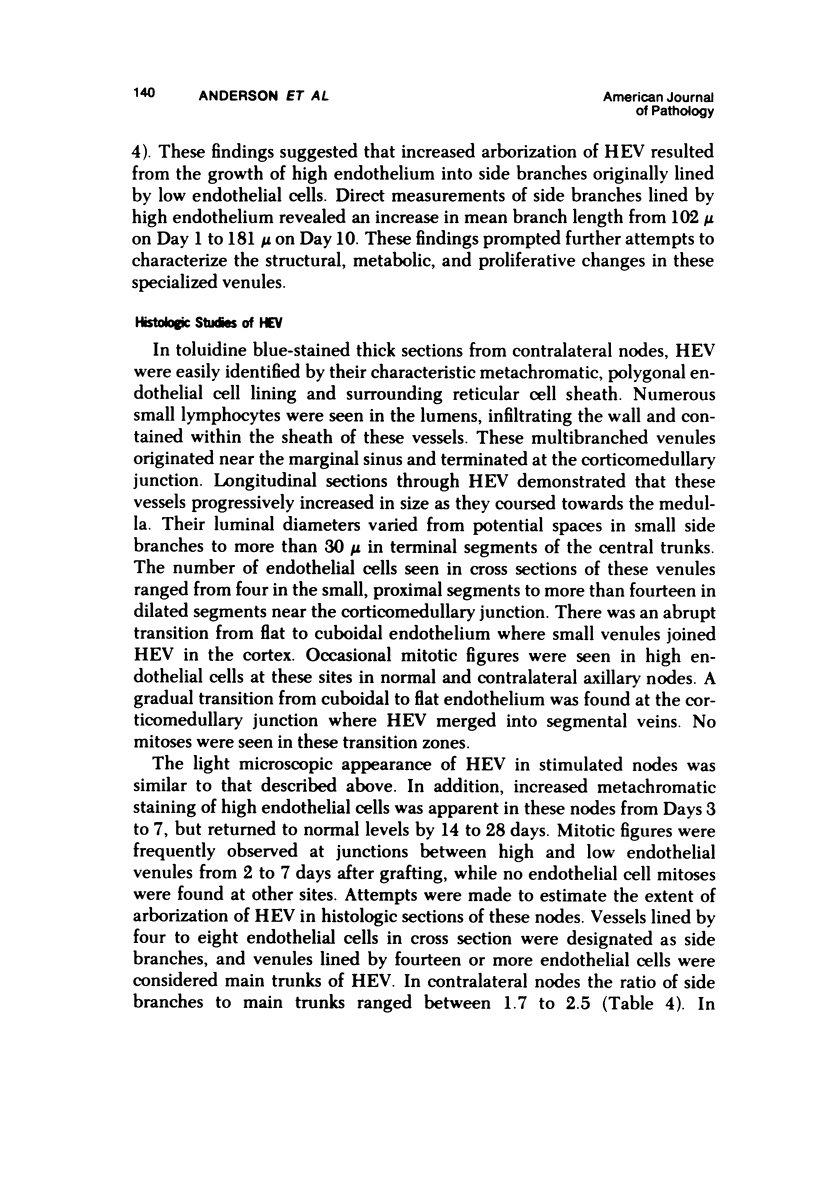
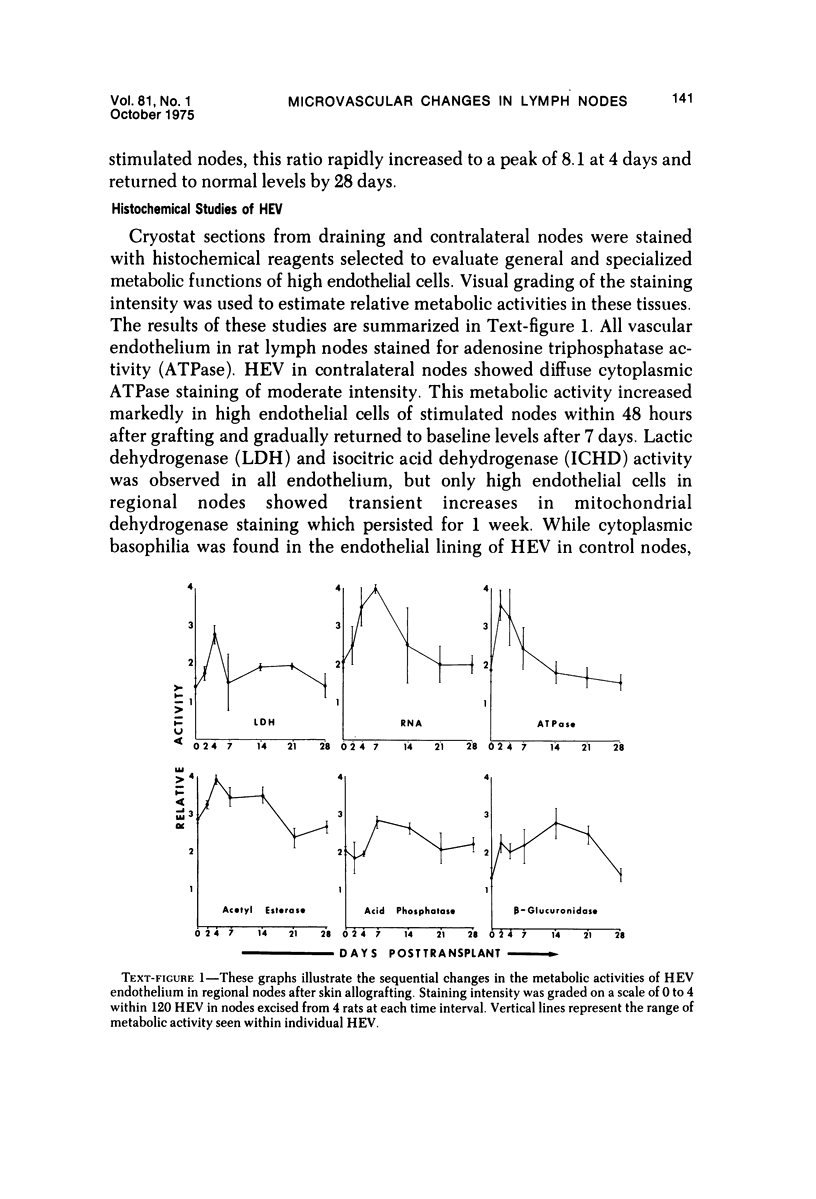
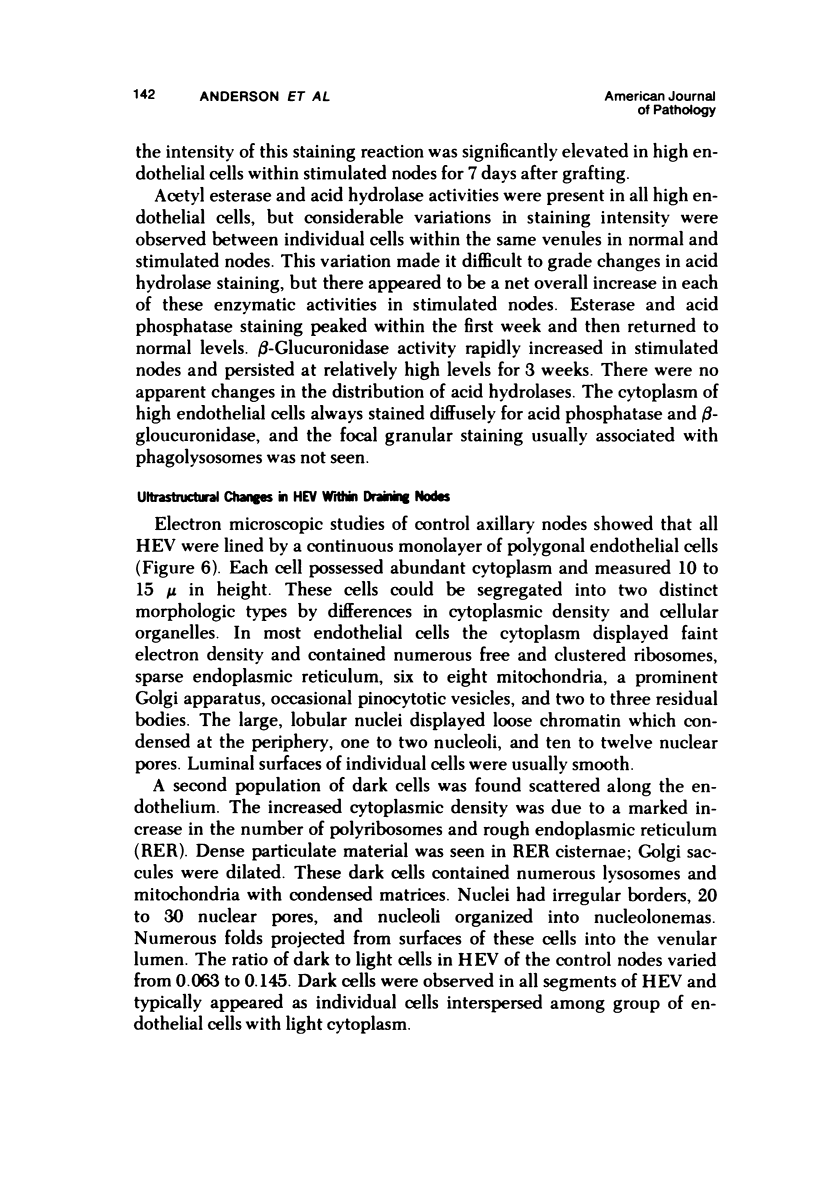
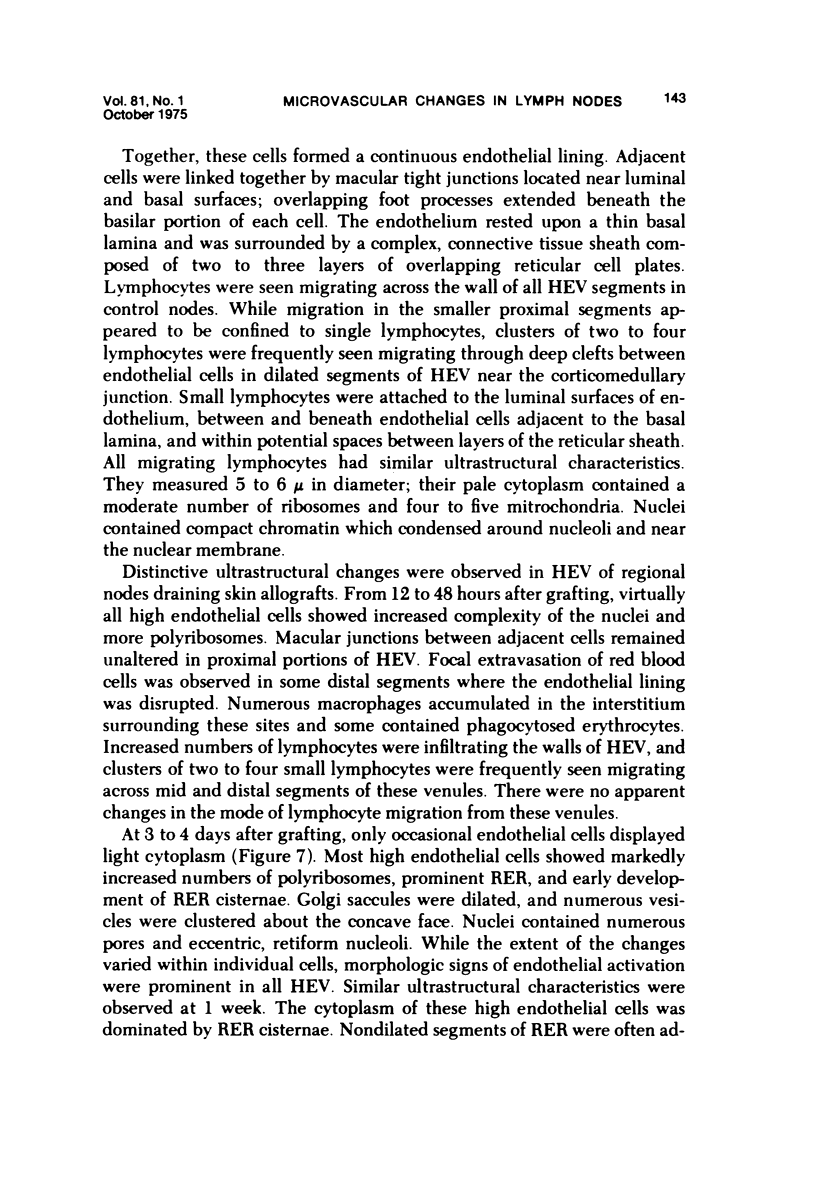
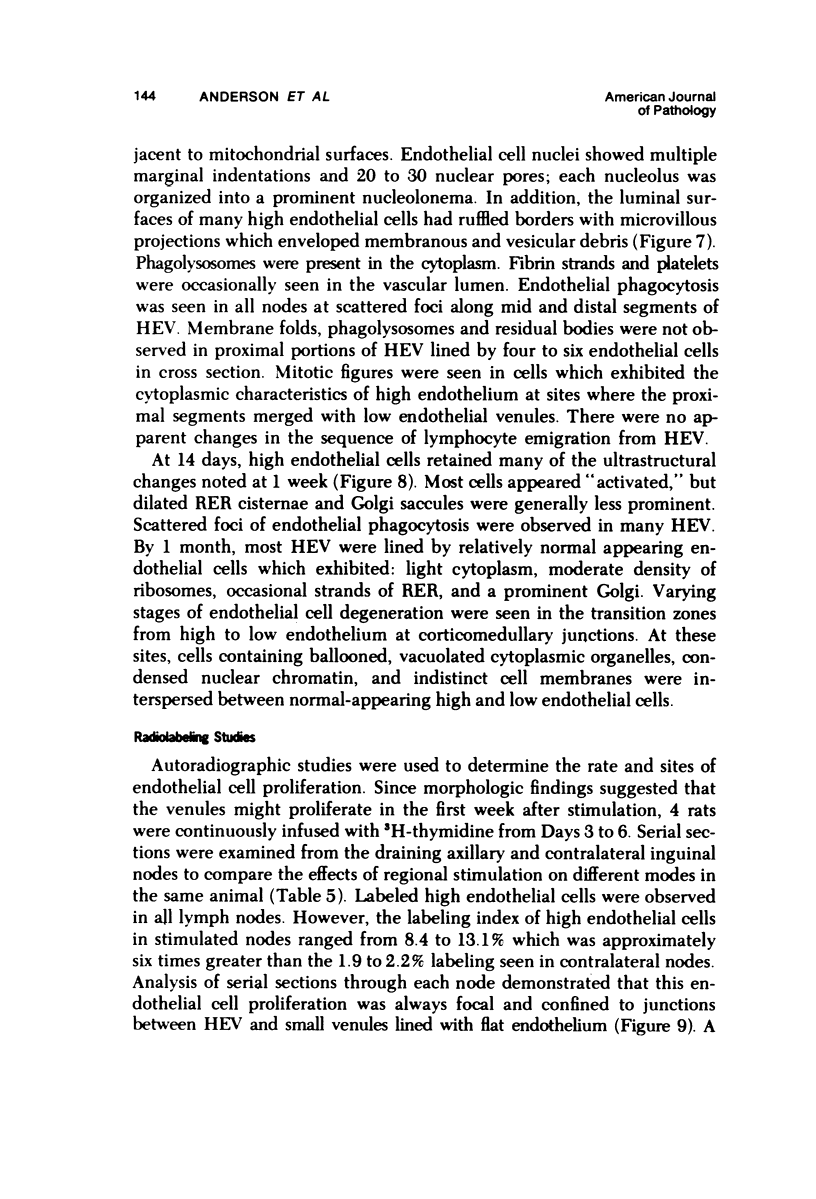
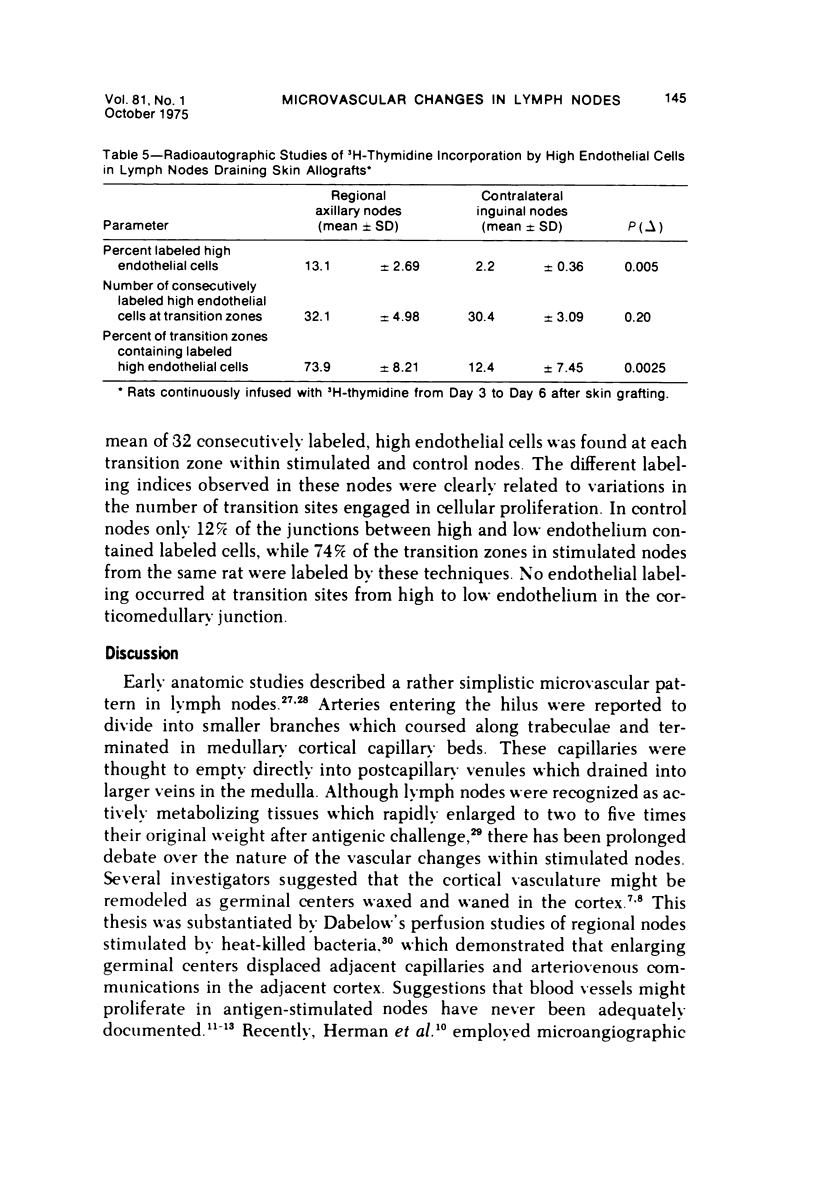
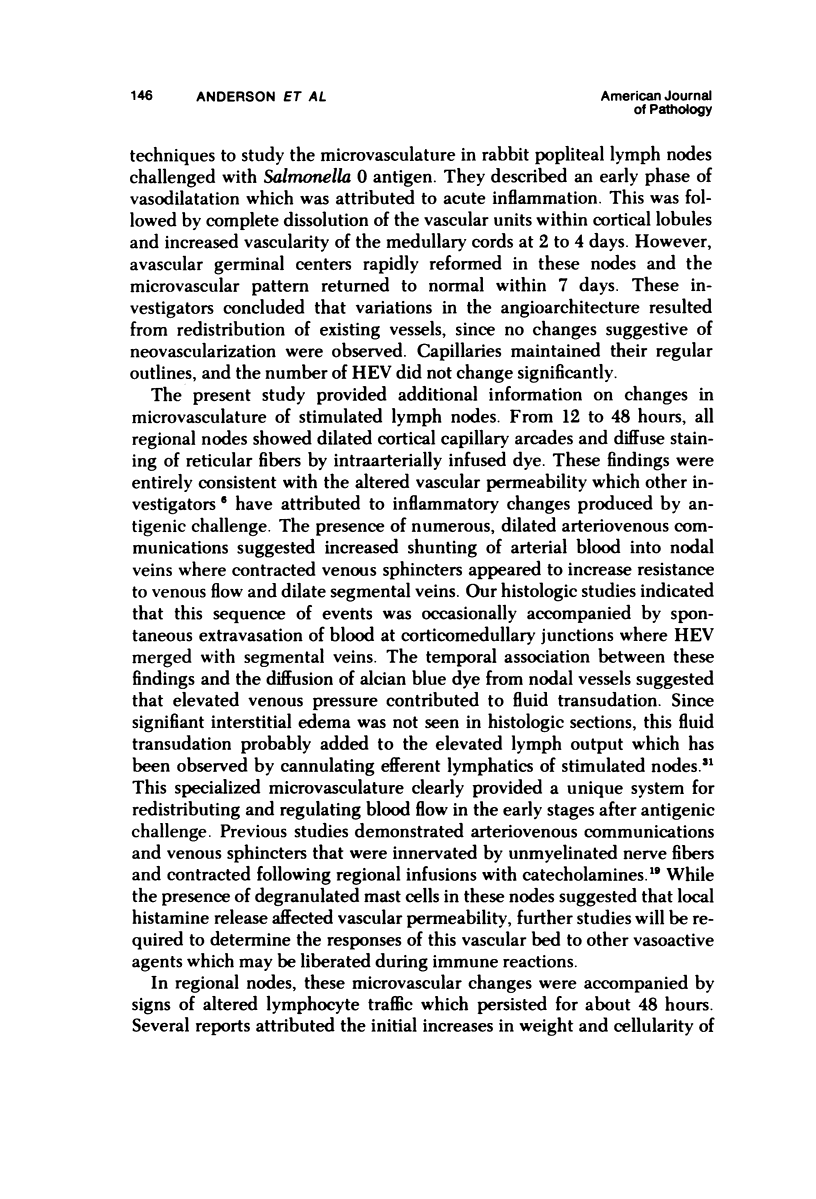
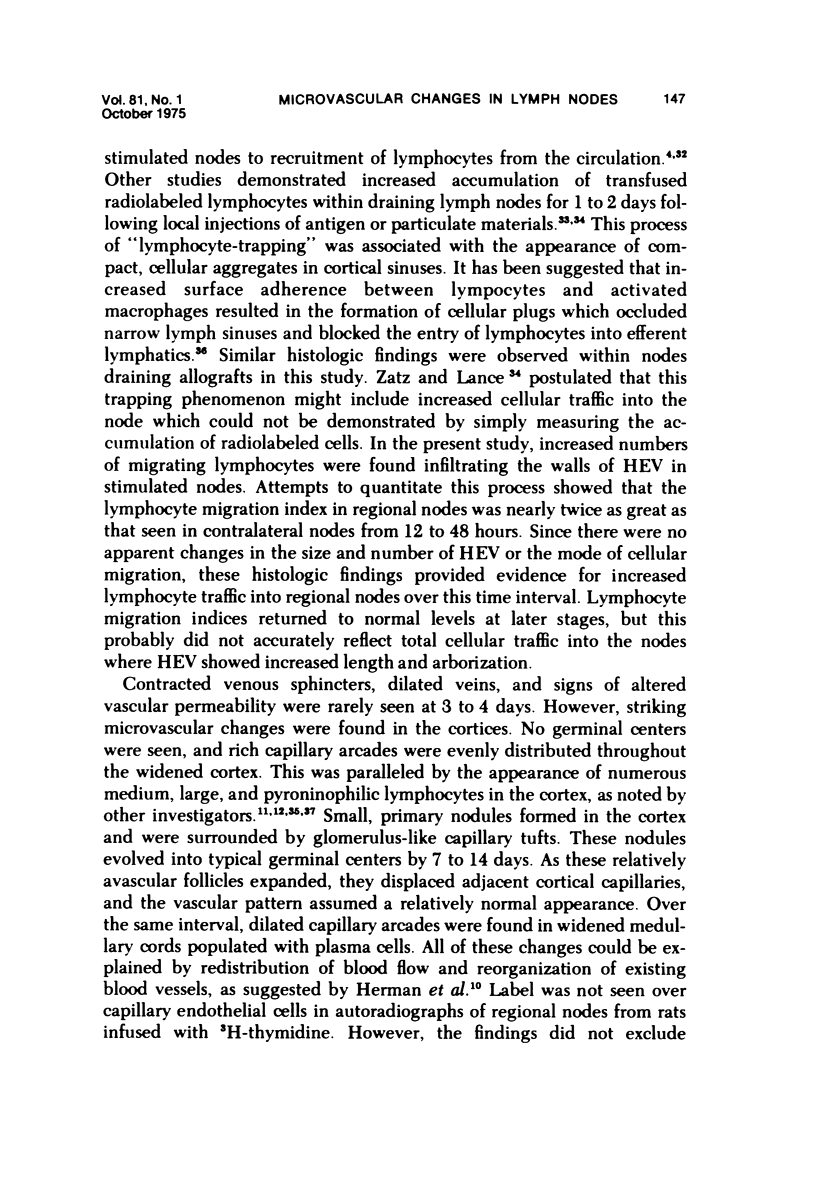
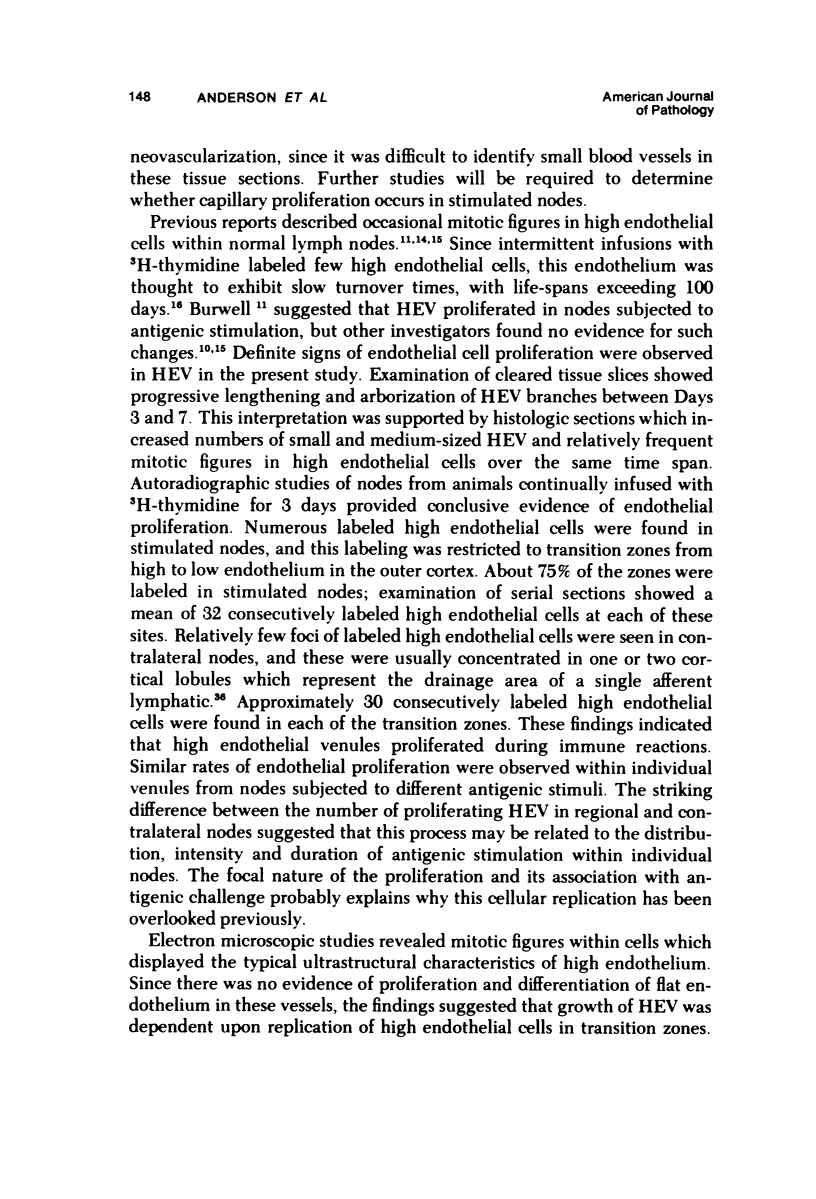
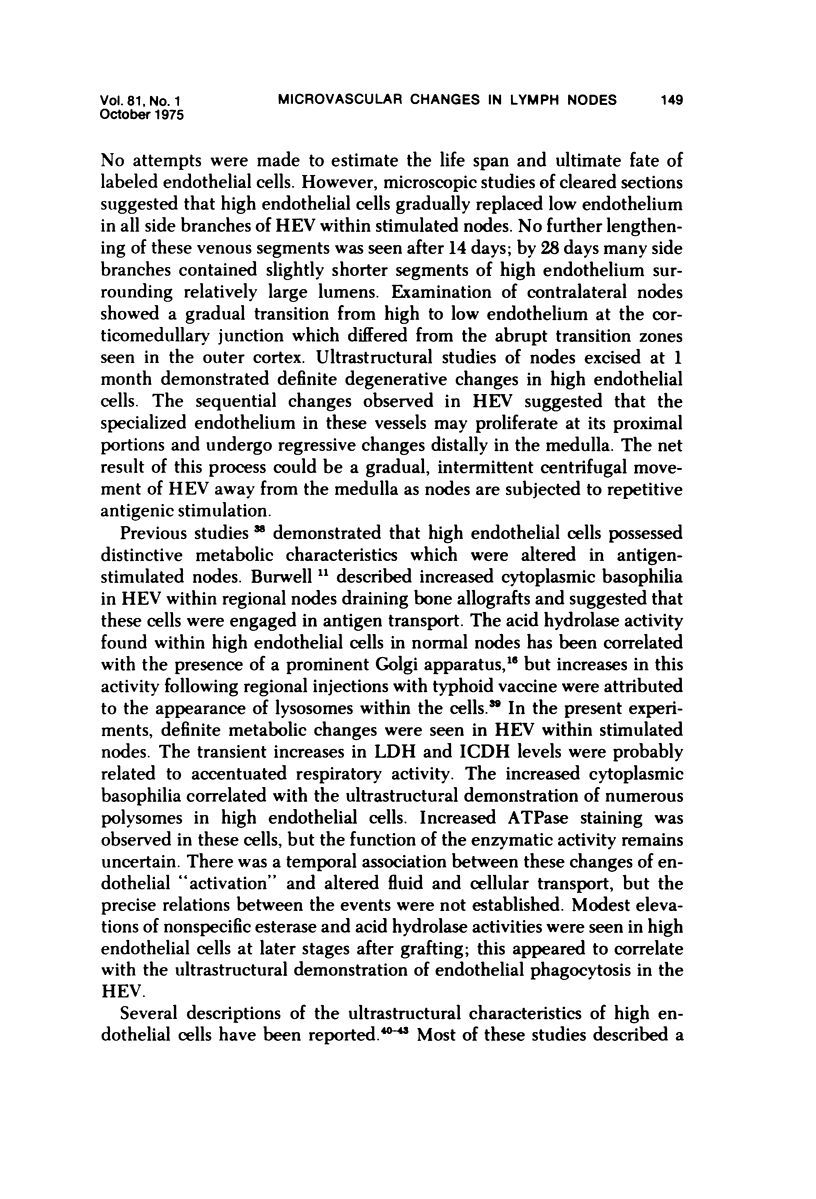
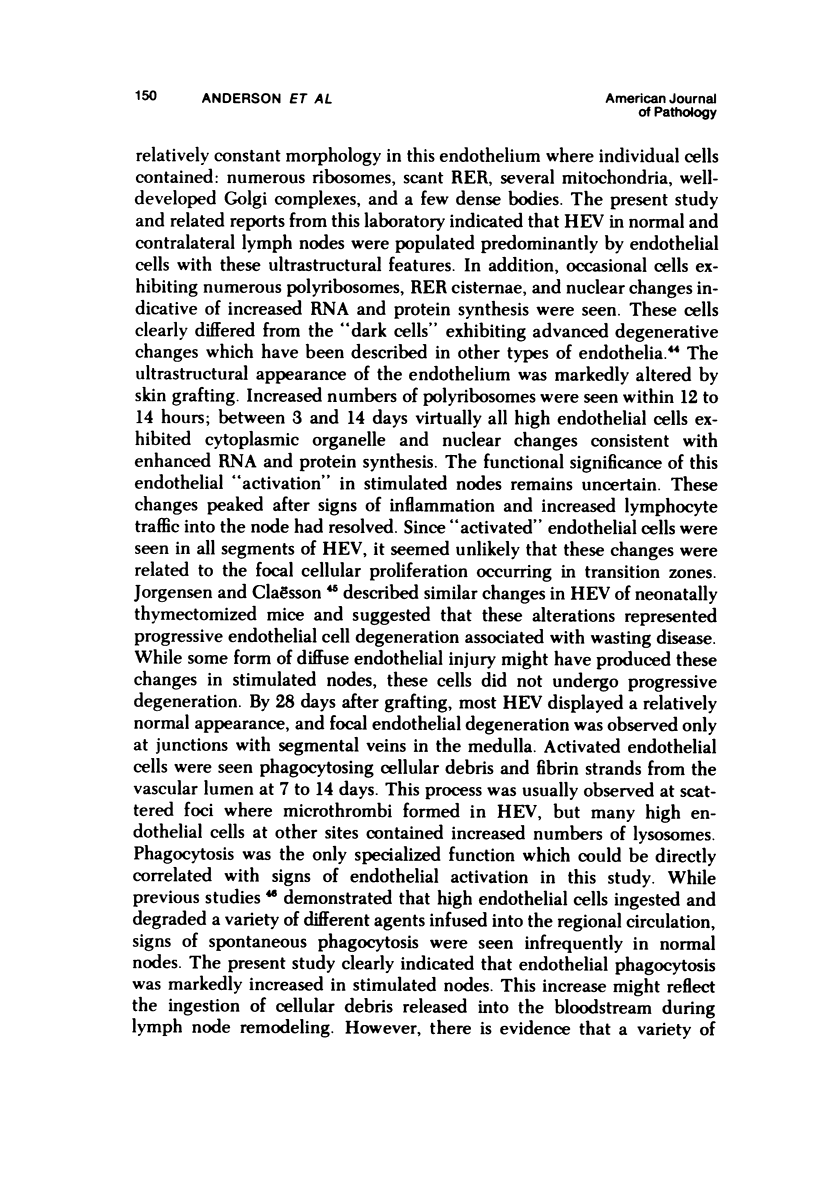
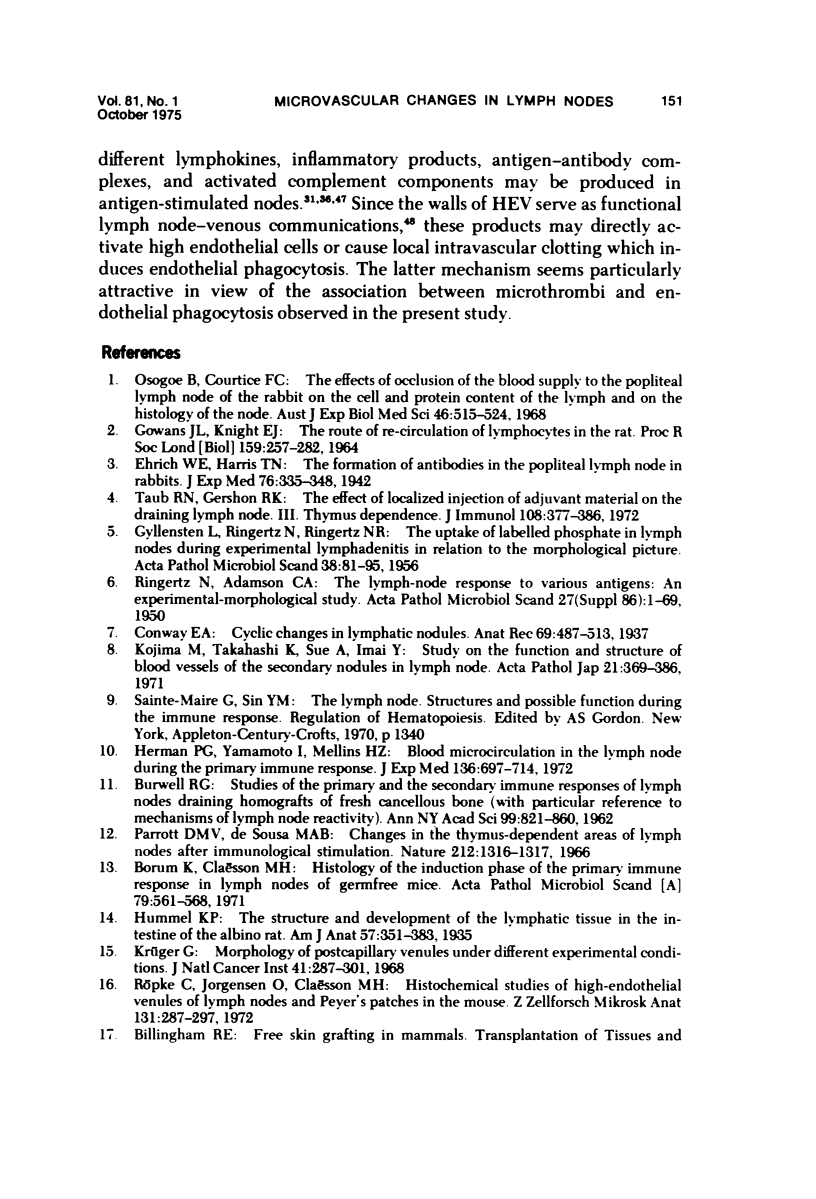
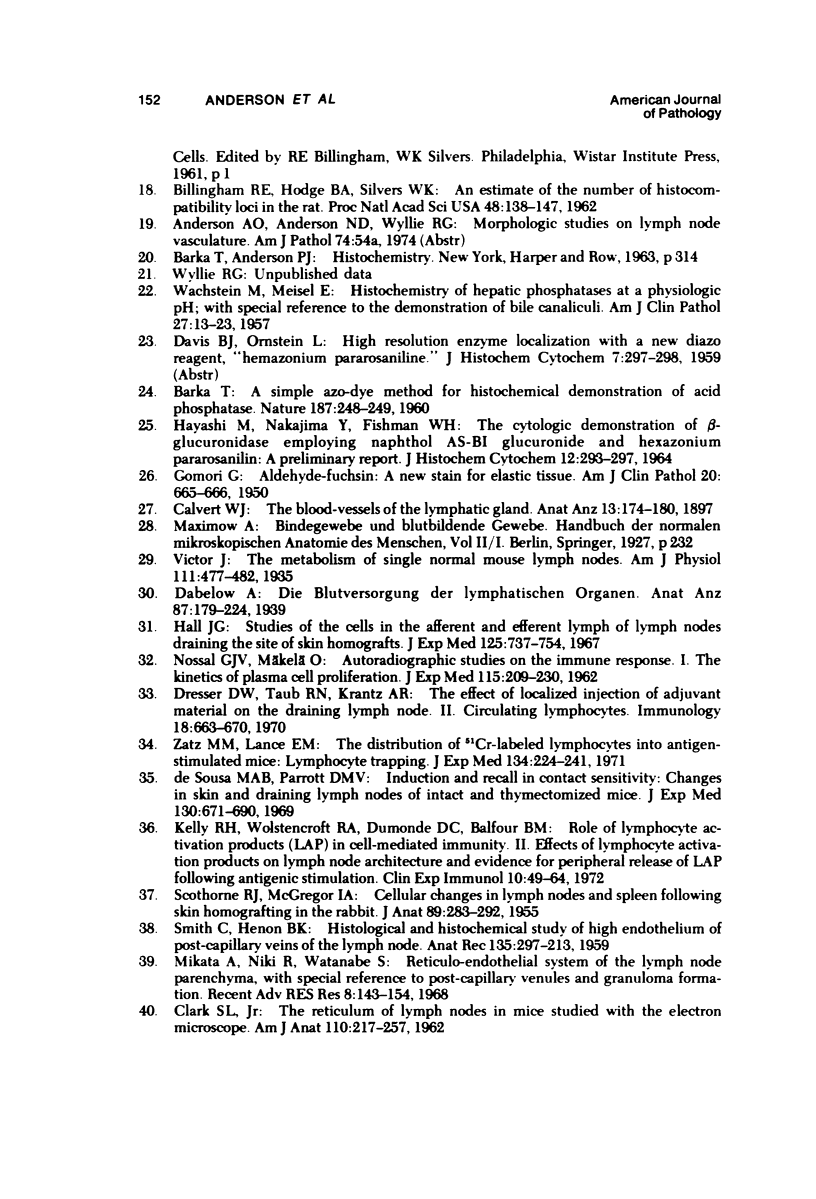
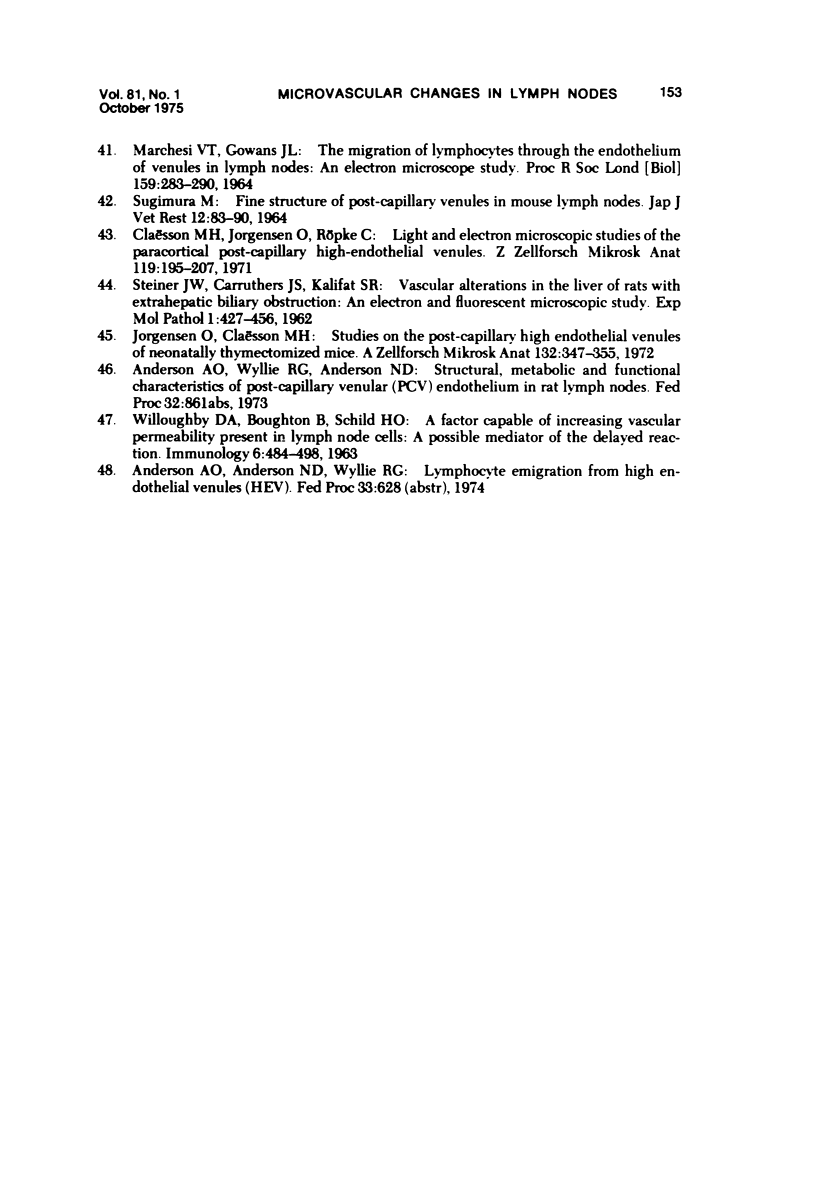
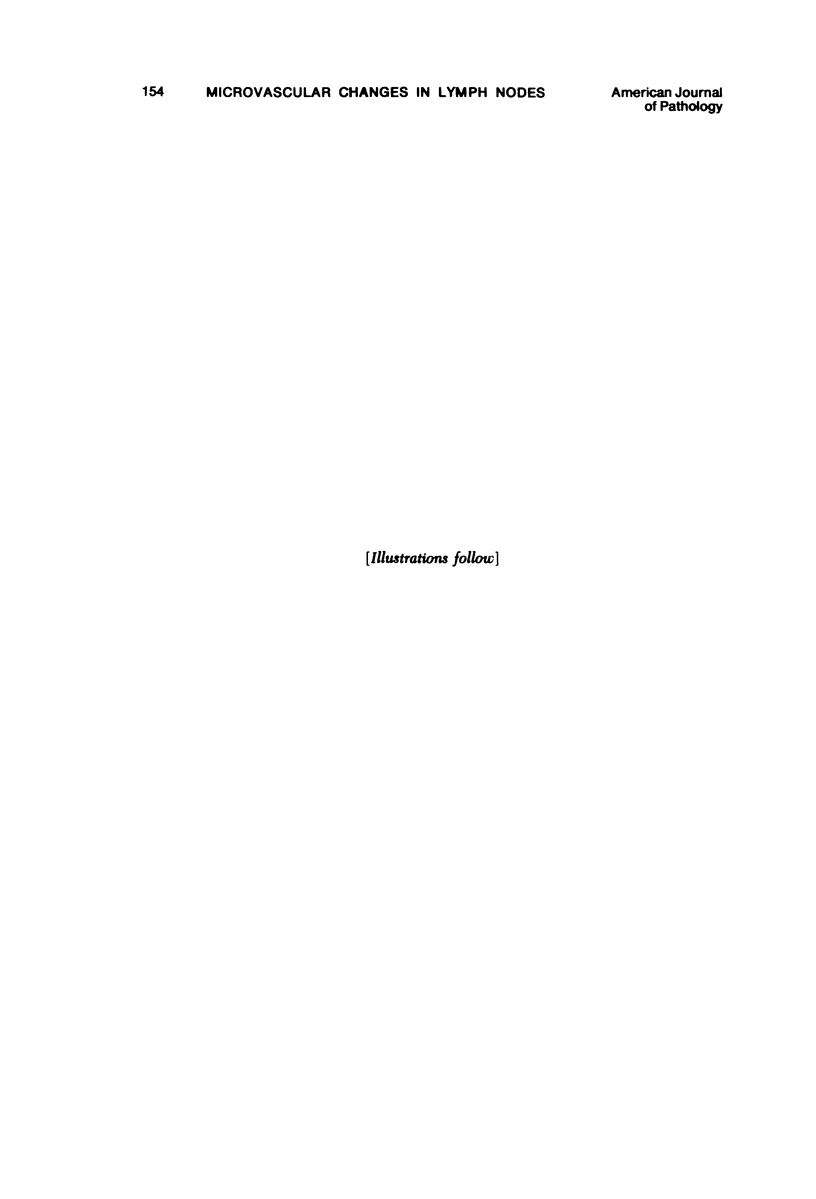
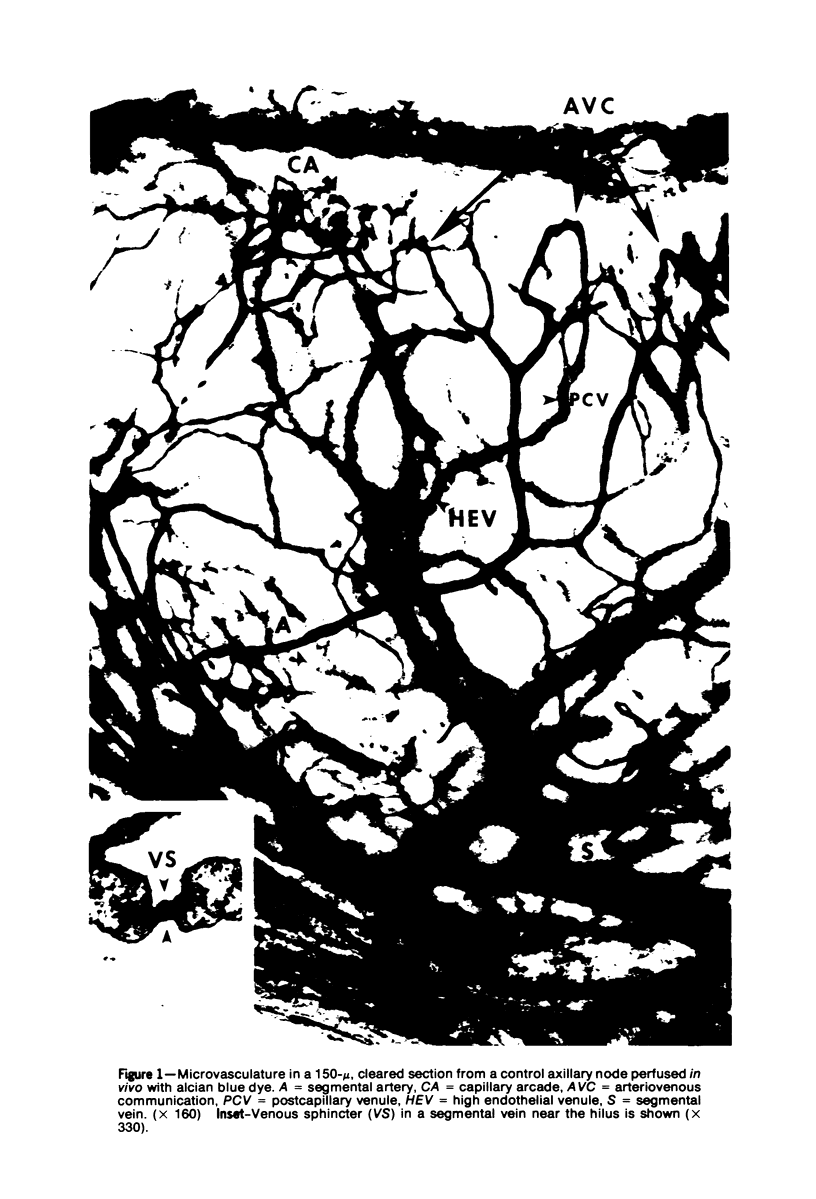
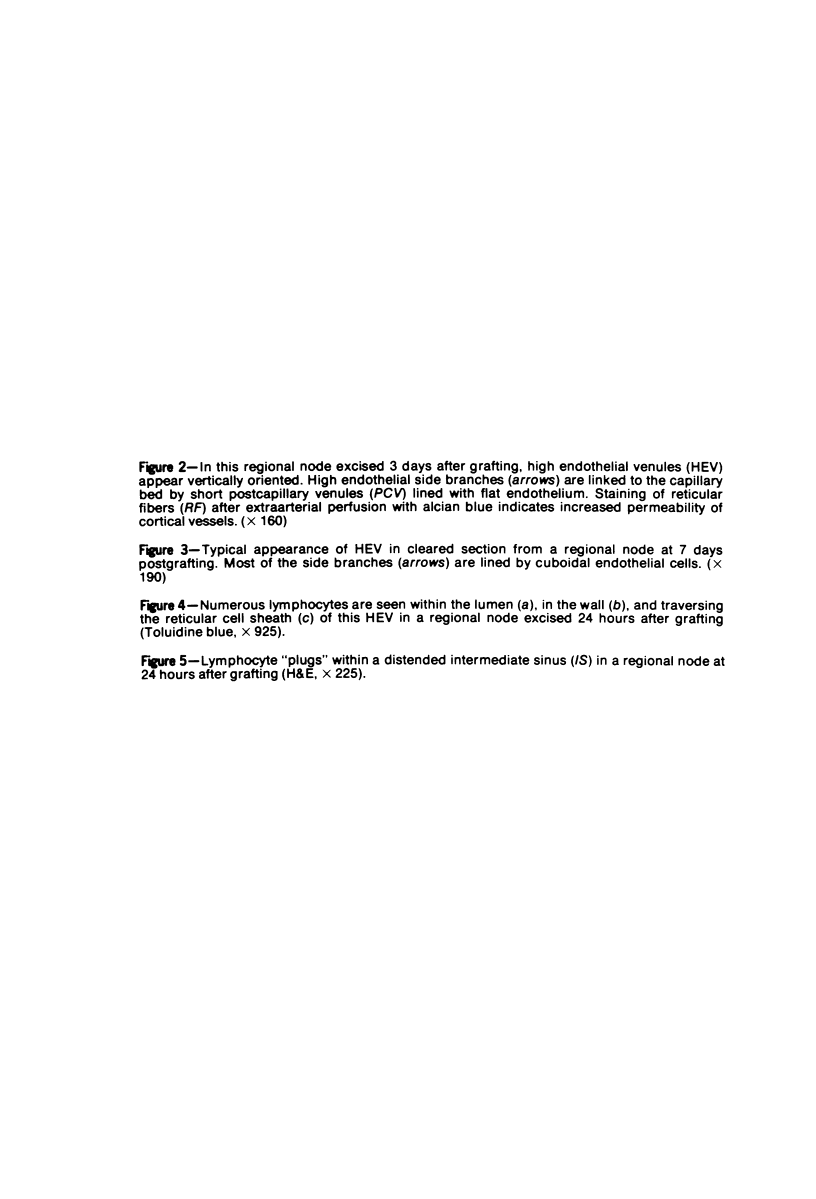
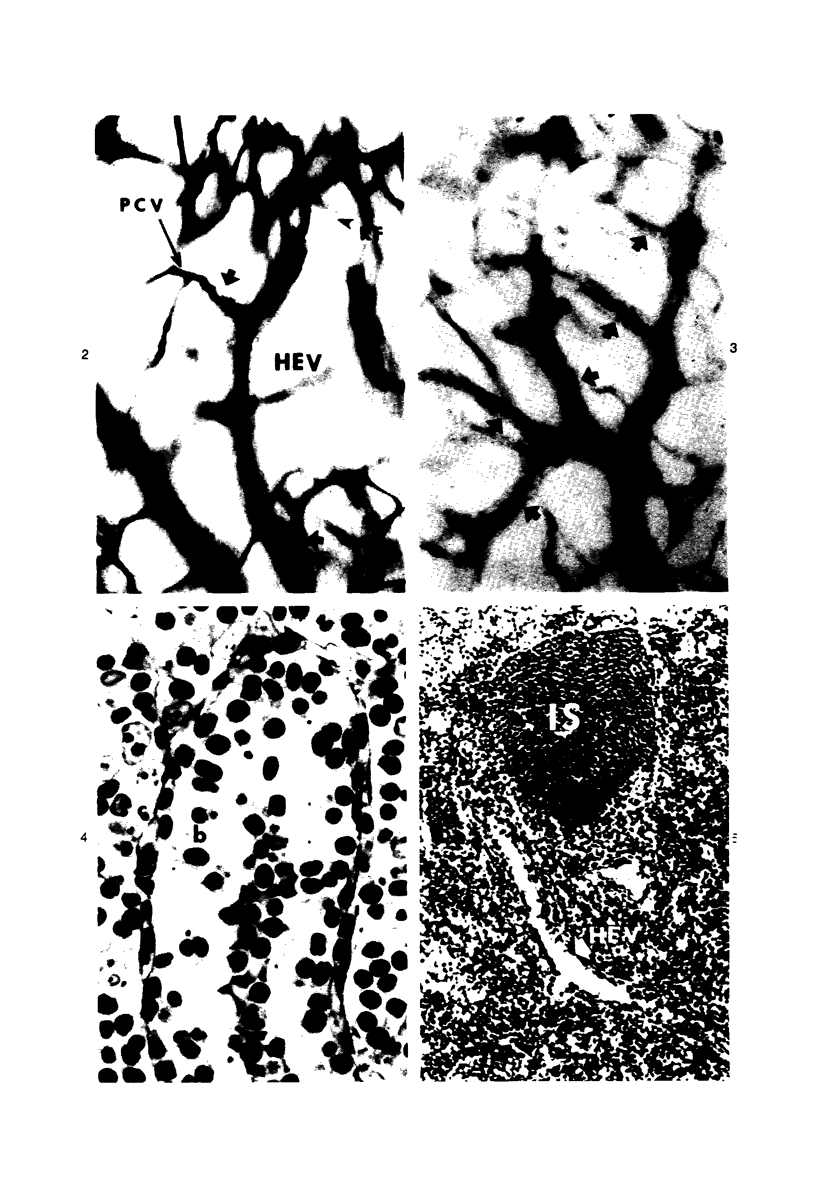
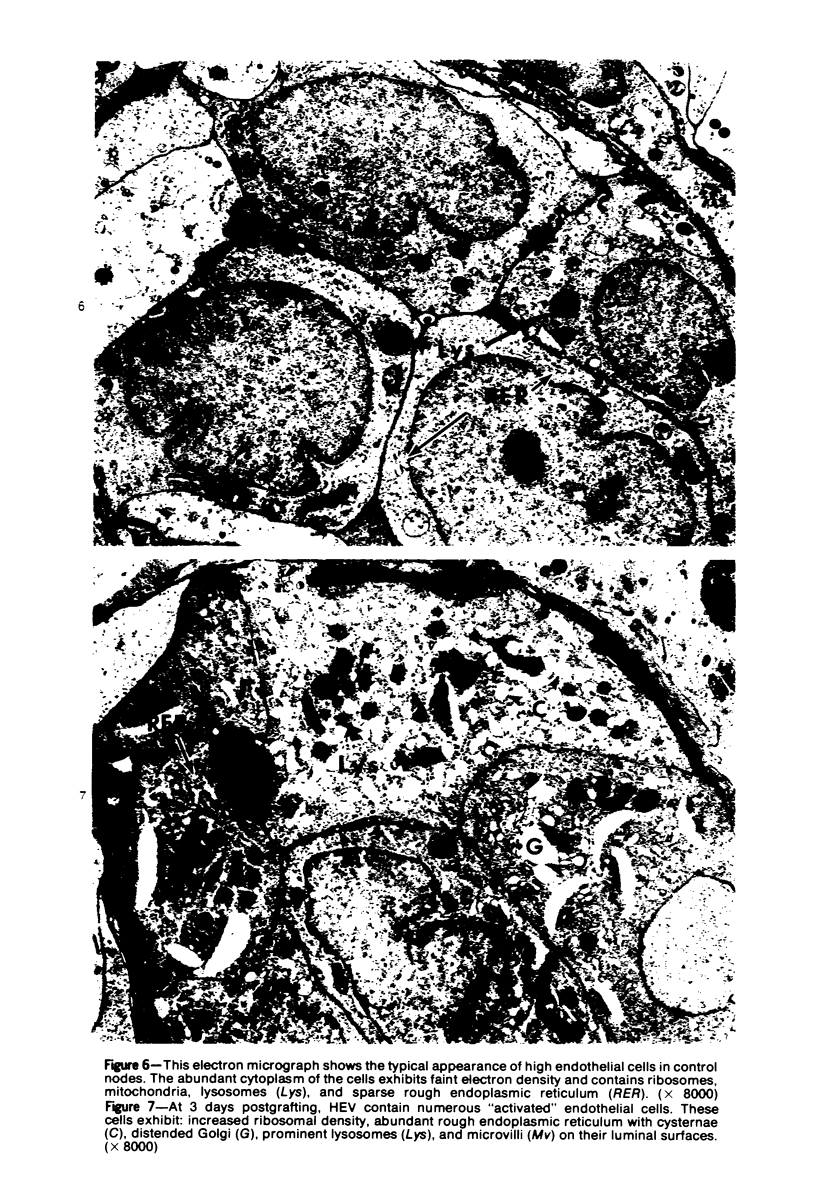
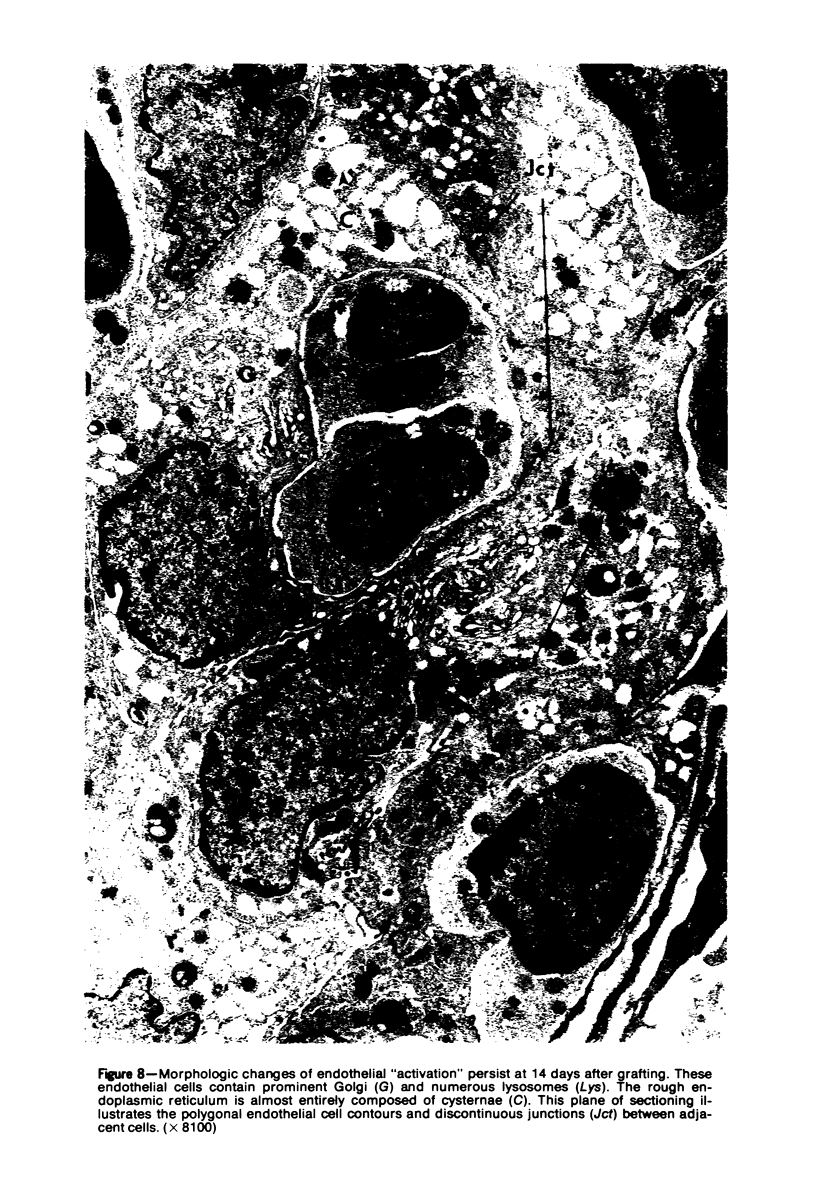
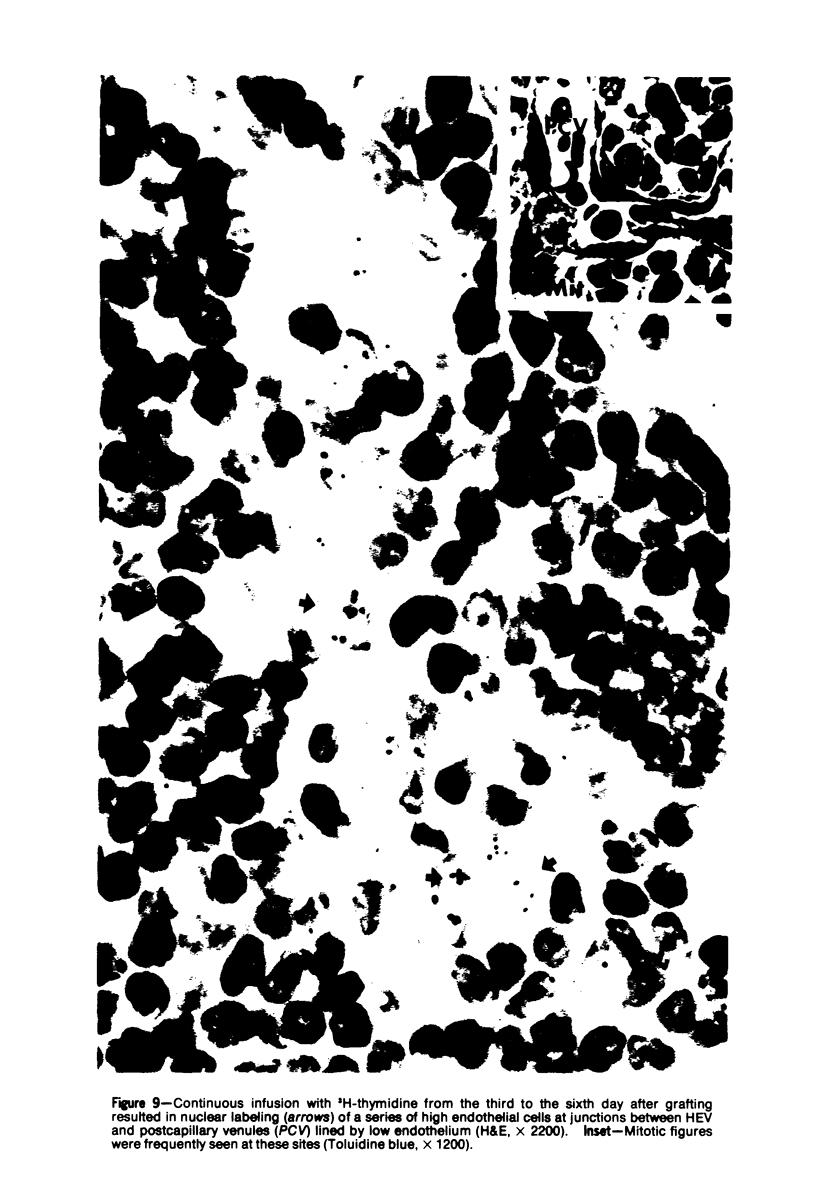
Images in this article
Selected References
These references are in PubMed. This may not be the complete list of references from this article.
- BARKA T. A simple azo-dye method for histochemical demonstration of acid phosphatase. Nature. 1960 Jul 16;187:248–249. doi: 10.1038/187248a0. [DOI] [PubMed] [Google Scholar]
- BILLINGHAM R. E., HODGE B. A., SILVERS W. K. An estimate of the number of histocompatibility loci in the rat. Proc Natl Acad Sci U S A. 1962 Feb;48:138–147. doi: 10.1073/pnas.48.2.138. [DOI] [PMC free article] [PubMed] [Google Scholar]
- BURWELL R. G. Studies of the primary and the secondary immune responses of lymph nodes draining homografts of fresh cancellous bone (with particular reference to mechanisms of lymph node reactivity). Ann N Y Acad Sci. 1962 Oct 24;99:821–860. doi: 10.1111/j.1749-6632.1962.tb45365.x. [DOI] [PubMed] [Google Scholar]
- Borum K., Claesson M. H. Histology of the induction phase of the primary immune response in lymph nodes of germfree mice. Acta Pathol Microbiol Scand A. 1971;79(6):561–568. doi: 10.1111/j.1699-0463.1971.tb01858.x. [DOI] [PubMed] [Google Scholar]
- CLARK S. L., Jr The reticulum of lymph nodes in mice studied with the electron microscope. Am J Anat. 1962 May;110:217–257. doi: 10.1002/aja.1001100303. [DOI] [PubMed] [Google Scholar]
- Claesson M. H., Jorgensen O., Ropke C. Light and electron microscopic studies of the paracortical post-capillary high-endothelial venules. Z Zellforsch Mikrosk Anat. 1971;119(2):195–207. doi: 10.1007/BF00324521. [DOI] [PubMed] [Google Scholar]
- Dresser D. W., Taub R. N., Krantz A. R. The effect of localized injection of adjuvant material on the draining lymph node. II. Circulating lymphocytes. Immunology. 1970 May;18(5):663–670. [PMC free article] [PubMed] [Google Scholar]
- GOMORI G. Aldehyde-fuchsin: a new stain for elastic tissue. Am J Clin Pathol. 1950 Jul;20(7):665–666. [PubMed] [Google Scholar]
- GOWANS J. L., KNIGHT E. J. THE ROUTE OF RE-CIRCULATION OF LYMPHOCYTES IN THE RAT. Proc R Soc Lond B Biol Sci. 1964 Jan 14;159:257–282. doi: 10.1098/rspb.1964.0001. [DOI] [PubMed] [Google Scholar]
- GYLLENSTEN L., RINGERTZ N., RINGERTZ N. R. The uptake of labelled phosphate in lymph nodes during experimental lymphadenitis in relation to the morphological picture. Acta Pathol Microbiol Scand. 1956;38(2):81–95. doi: 10.1111/j.1699-0463.1956.tb00980.x. [DOI] [PubMed] [Google Scholar]
- HAYASHI M., NAKAJIMA Y., FISHMAN W. H. THE CYTOLOGIC DEMONSTRATION OF BETA-GLUCURONIDASE EMPLOYING NAPHTHOL AS-BI GLUCURONIDE AND HEXAZONIUM PARAROSANILIN; A PRELIMINARY REPORT. J Histochem Cytochem. 1964 Apr;12:293–297. doi: 10.1177/12.4.293. [DOI] [PubMed] [Google Scholar]
- Hall J. G. Studies of the cells in the afferent and efferent lymph of lymph nodes draining the site of skin homografts. J Exp Med. 1967 May 1;125(5):737–754. doi: 10.1084/jem.125.5.737. [DOI] [PMC free article] [PubMed] [Google Scholar]
- Herman P. G., Yamamoto I., Mellins H. Z. Blood microcirculation in the lymph node during the primary immune response. J Exp Med. 1972 Oct 1;136(4):697–714. doi: 10.1084/jem.136.4.697. [DOI] [PMC free article] [PubMed] [Google Scholar]
- Jorgensen O., Claësson M. H. Studies on the post-capillary high endothelial venules of neonatally thymectomized mice. Z Zellforsch Mikrosk Anat. 1972;132(3):347–355. [PubMed] [Google Scholar]
- Kelly R. H., Wolstencroft R. A., Dumonde D. C., Balfour B. M. Role of lymphocyte activation products (LAP) in cell-mediated immunity. II. Effects of lymphocyte activation products on lymph node architecture and evidence for peripheral release of LAP following antigenic stimulation. Clin Exp Immunol. 1972 Jan;10(1):49–65. [PMC free article] [PubMed] [Google Scholar]
- Kojima M., Takahashi K., Sue A., Imai Y. Study on the function and structure of blood vessels of the secondary nodules in lymph node. Acta Pathol Jpn. 1971 Aug;21(3):369–386. doi: 10.1111/j.1440-1827.1971.tb00130.x. [DOI] [PubMed] [Google Scholar]
- Krüger G. Morphology of postcapillary venules under different experimental conditions. J Natl Cancer Inst. 1968 Aug;41(2):287–301. [PubMed] [Google Scholar]
- MARCHESI V. T., GOWANS J. L. THE MIGRATION OF LYMPHOCYTES THROUGH THE ENDOTHELIUM OF VENULES IN LYMPH NODES: AN ELECTRON MICROSCOPE STUDY. Proc R Soc Lond B Biol Sci. 1964 Jan 14;159:283–290. doi: 10.1098/rspb.1964.0002. [DOI] [PubMed] [Google Scholar]
- NOSSAL G. J., MAKELA O. Autoradiographic studies on the immune response.I. The kinetics of plasma cell proliferation. J Exp Med. 1962 Jan 1;115:209–230. doi: 10.1084/jem.115.1.209. [DOI] [PMC free article] [PubMed] [Google Scholar]
- Osogoe B., Courtice F. C. The effects of occlusion of the blood supply to the popliteal lymph node of the rabbit on the cell and protein content of the lymph and on the histology of the node. Aust J Exp Biol Med Sci. 1968 Oct;46(5):515–524. doi: 10.1038/icb.1968.159. [DOI] [PubMed] [Google Scholar]
- Parrott D. M., de Sousa M. A. Changes in the thymus-dependent areas of lymph nodes after immunological stimulation. Nature. 1966 Dec 17;212(5068):1316–1317. doi: 10.1038/2121316a0. [DOI] [PubMed] [Google Scholar]
- RINGERTZ N., ADAMSON C. A. The lymph-node response to various antigens; an experimental-morphological study. Acta Pathol Microbiol Scand Suppl. 1950;86:1–69. [PubMed] [Google Scholar]
- Röpke C., Jorgensen O., Claësson M. H. Histochemical studies of high-endothelial venules of lymph nodes and Peyer's patches in the mouse. Z Zellforsch Mikrosk Anat. 1972;131(3):287–297. doi: 10.1007/BF00582852. [DOI] [PubMed] [Google Scholar]
- SCOTHORNE R. J., MCGREGOR I. A. Cellular changes in lymph nodes and spleen following skin homografting in the rabbit. J Anat. 1955 Jul;89(3):283–292. [PMC free article] [PubMed] [Google Scholar]
- SMITH C., HENON B. K. Histological and histochemical study of high endothelium of post-capillary veins of the lymph node. Anat Rec. 1959 Nov;135:207–213. doi: 10.1002/ar.1091350306. [DOI] [PubMed] [Google Scholar]
- STEINER J. W., CARRUTHERS J. S., KALIFAT S. R. Vascular alterations in the liver of rats with extrahepatic biliary obstruction. An electron and fluorescent microscopic study. Exp Mol Pathol. 1962 Oct;1:427–456. doi: 10.1016/0014-4800(62)90035-7. [DOI] [PubMed] [Google Scholar]
- Taub R. N., Gershon R. K. The effect of localized injection of adjuvant material on the draining lymph node. 3. Thymus dependence. J Immunol. 1972 Feb;108(2):377–386. [PubMed] [Google Scholar]
- WACHSTEIN M., MEISEL E. Histochemistry of hepatic phosphatases of a physiologic pH; with special reference to the demonstration of bile canaliculi. Am J Clin Pathol. 1957 Jan;27(1):13–23. doi: 10.1093/ajcp/27.1.13. [DOI] [PubMed] [Google Scholar]
- WILLOUGHBY D. A., BOUGHTON B., SCHILD H. O. A FACTOR CAPABLE OF INCREASING VASCULAR PERMEABILITY PRESENT IN LYMPH NODE CELLS. A POSSIBLE MEDIATOR OF THE DELAYED REACTION. Immunology. 1963 Sep;6:484–498. [PMC free article] [PubMed] [Google Scholar]
- Zatz M. M., Lance E. M. The distribution of 51Cr-labeled lymphocytes into antigen-stimulated mice. Lymphocyte trapping. J Exp Med. 1971 Jul 1;134(1):224–241. doi: 10.1084/jem.134.1.224. [DOI] [PMC free article] [PubMed] [Google Scholar]
- de Sousa M. A., Parrott D. M. Induction and recall in contact sensivitity. Changes in skin and draining lymph nodes of intact and thymectomized mice. J Exp Med. 1969 Oct 1;130(4):671–690. doi: 10.1084/jem.130.4.671. [DOI] [PMC free article] [PubMed] [Google Scholar]





